Communication Objectives
Identify and name school workers
Describe school workers’ tasks
Understand and follow simple commands

Identify and name school workers
Describe school workers’ tasks
Understand and follow simple commands
Identify places at school
Identify location of people: upstairs, downstairs, inside, outside
School Workers: principal, secretary, English teacher, music teacher, gym teacher, janitor, gatekeeper, bus driver
Places at School: classroom, office, bathroom, playground
Days of the Week
Numbers: zero to nineteen


Action Verbs: run, jump, walk, hop, clap, sleep, wiggle, sing, dance, march, turn around, wave, shake, stretch, stand up, sit down, look, predict, draw, listen, say, find, match, guess, teach, clean, open, close, drive, help, play, learn, tap, trace, cross out, scratch, roar, cut out, paste, read, respect, count, stick, blink, stomp, work, build, make, fold, tape, paint, bend, ask, answer, check
Nature and Science Words: bee, honeycomb
Who is (he)? (He) is the (music teacher).
What does the (janitor) do? (He) (cleans the school). Where is the (secretary)? (She) is (in the office).
Math:
Identify and trace numbers: 1–19
Identify and count sets of 10
Count to 19
Nature and Science:
Observe how bees work together to make a honeycomb
Art
Make bees
Music:
Sing and act out songs
Move and dance to music
Language Arts: Say and act out chants
Role-play
Observe how bees work together to make a honeycomb
Project: Make Bees
Who Is She?
Competency work within the following formative areas:
Mathematical Thinking:
Use numbers in diverse situations to draw on the principles of counting; Math page, p. T11
Practice motor skills
Practice visual discrimination
Identify and trace uppercase and lowercase letters: Mm, Ss, Ff, Aa
Language and Communication:
Obtain information through diverse forms of oral expression; Vocabulary pages, pp. T2–T3
Identify initial sounds: /m/, /s/, /f/, /æ/
Trace words and use rebuses to read phrases
home the Little Book Use props to role-play at home
Objectives
• To exchange greetings
• To predict unit topic
• To identify school workers
• To understand and follow simple commands
Vocabulary
hello, good-bye, bus driver, music teacher, English teacher, run, jump, walk, hop, clap, sleep, wiggle, sing, dance, march, turn around, wave, shake, stretch, stand up, sit down, look, predict, draw, listen
Language
Do we find (a music teacher) at school? Find the bus drivers.
Materials
Class Audio CD, Happy Caterpillar puppet, paper, pencils, Portfolio Envelopes
Sing the “Good Morning Song”
A3
Play the audio and have Happy Caterpillar welcome children to class. Turn to the puppet and say: Good morning, Happy Caterpillar!
I am glad to see you. Have him answer: Good morning, teacher and children. Then encourage children to say: Good morning.

Actions Whisper Game
Invite a child to the front and whisper a familiar action to him/her: run, jump, walk, hop, clap, sleep, wiggle, sing, dance, march, turn around, wave, shake, stretch, stand up, or sit down. Invite him/her to perform the action, and have the rest of the class call out the name of
the action and mimic the child. Continue the procedure for the rest of the actions and with other children.
A5, A8
1 Look, predict, and draw. Listen. Predict Together
Display page 1 and have children look at the pictures. Ask: Where can we find these people? They may say it in their native language if they cannot say it in English: Yes, very good. We can find these people at school. What do you think this unit will be about? Encourage children to answer: School. Then play Audio A5. Have children listen. Encourage them to mime the actions with you. At the end of the song, fill in the missing word: Fun with (school)! Next, have children close their books. Hand out paper and pencils and invite children to draw one more person or school worker that they imagine will appear in the unit based on the topic they just predicted. When finished, invite children to hold up their drawings and name the item that they drew.
Have children flip through the pages of the unit to check their predictions. Have children clap if they see the school worker they predicted. Then display page 1 again. Point to the pictures on the page and ask: Do we find a music teacher at school? Do we find a bus driver at school? Elicit affirmative answers in each case. Continue the procedure for the rest of the pictures.
Next, point to the top left picture and ask children what they see. Elicit: children, musical instruments, teacher, etc. Point to the woman and tell children: She is a music teacher. Have children repeat after you. Continue the procedure with the rest of the pictures.
Finally, play the Target Song “People at School” (A8) to expose children to the new vocabulary.

Encourage children to mimic your gestures for the song. As each target word is mentioned, have children jump in place. Encourage them to clap at the end of the song.
Point out Happy Caterpillar with the bus driver and say: Find the bus drivers. Encourage children to flip through the Unit 1 pages. Repeat: Find the bus drivers. (There are bus drivers on pages 1, 2, 3, and 14.)
Sing the “We Have Finished Chant”
A6
Play the audio and invite children to join in with the actions. Play the audio a second time and have children join in when they can.
Sing the “Good-bye Song”
A7
Play the audio. Invite children to sing along and wave good-bye.
Gather letter-sized or smaller work throughout the year for Portfolios for Level 3. Use the Stickers envelope as the Portfolio. Attach one “Portfolio” Sticker to each envelope and write the child’s name on it. Add to the Portfolio work that children feel good about and that shows their progress.

See Workbook page 1.
Take children on a tour of the school. Introduce them to each school worker in turn and say what they do: This is (Ms. Thompson). (She) is the (music teacher). Encourage children to greet each person they meet.
















1 Look, predict, and draw. Listen.








































2 Listen and say. Find and match.



































Objectives
• To identify school workers
• To repeat names of school workers
• To review inside and outside
• To review the days of the week
• To understand and follow simple commands
Vocabulary school, principal, secretary, English teacher, music teacher, inside, outside, days of the week, listen, say, find, match, guess
Language
Who is (he)? (He) is the (music teacher).
Materials
Class Audio CD, Happy Caterpillar puppet, principal, secretary, English teacher, and music teacher Picture Cards, a large calendar with the days of the week, pencils
Vocabulary Presentation
Hold up each Picture Card in turn and name it: principal, secretary, English teacher, and music teacher. Have Happy Caterpillar name them after you. Then invite children to repeat the names. Next, point to yourself and say: I am (an)… Pause and elicit: English teacher.
Sing “How Many Days?”
A4
Display a large calendar and have children look at it. Point to each day of the week, have Happy Caterpillar say the day, and have children repeat after him. Then play the audio and have children join in when they can. Have the puppet point to each day as it is mentioned.
A8
Sing the Target Song
Play the Target Song “People at School.” Sing the questions and have Happy Caterpillar sing the answers. Show the appropriate Picture Card each time a person is mentioned.

A9, A10
2 Listen and say. Find and match.
Play Audio A9. Point to each person in turn and have children do the same. Say the words and have children repeat. Next, have children look at the scene. Ask: Is the principal inside or outside? Elicit: Inside. Continue the procedure with the rest of the people. Then show children how to trace a line from the photo of the principal to the corresponding illustration in the scene. Encourage children to trace lines with their index finger before they do so with a pencil. Continue the procedure with the remaining photos.
Use the puppet to say the dialogue that goes with the scene: Who is he? He is the music teacher. Play Audio A10 and point to the corresponding illustrations as children repeat the target language.
Who is she? She is the principal. Who is she? She is the secretary. Who is she? She is the English teacher. Who is he? He is the music teacher.

Guess Who!
Invite a child to the front and give him/her one of the four Picture Cards, ensuring that the rest of the class does not see it. Invite him/her to act out the person on the card. Invite him/her to use props in the classroom to help. Ask children: Who is (he)? Invite them to guess which person is being acted out: (He) is the (music teacher). Continue the procedure for the rest of the Picture Cards and with other children.

See Workbook page 2.

Show a Picture Card for one of the school workers to the children without looking yourself. Invite a volunteer to impersonate the school worker on the card and have you guess which person it is. Continue the procedure for all the Unit 1 Picture Cards.
Objectives
• To identify school workers
• To repeat names of school workers
• To describe school workers’ tasks
• To review: inside, outside, upstairs, downstairs
• To understand and follow simple commands
Vocabulary
school, principal, secretary, English teacher, music teacher, gym teacher, janitor, gatekeeper, bus driver, inside, outside, upstairs, downstairs, listen, say, find, match, teach, clean, open, close, drive, help, play, learn, sing
Language
Is the (English teacher) (upstairs) or (downstairs)? (He) is (upstairs). What does the (janitor) do? (He) (cleans the school).
Materials
Class Audio CD, Happy Caterpillar puppet, Unit 1 Picture Cards, pencils, ball
Vocabulary Presentation
Hold up each Picture Card and have Happy Caterpillar say the name of the corresponding person. Have children repeat after the puppet. Then hold up each Picture Card again and have children say the name and mimic the action.
A8 Sing the Target Song
Play the Target Song “People at School” and have children listen attentively and join in when they can. Each time a person at school is mentioned, hold up the corresponding Picture Card.

A11–A13
3 Listen and say. Find and match.
Play Audio A11. Point to the photos of the vocabulary items, name them, and have children repeat them after you. Next, point to the scene and ask: Is the English teacher upstairs (mime climbing stairs) or downstairs (mime descending stairs)? Then point to the upper section of the picture and then to the lower section. Elicit: He is upstairs! Next, point to the bus driver and ask: Is the bus driver inside or outside? Elicit:
Outside. Continue to ask about the location of each person. Then show children how to trace a line from the photo of each person at school to the corresponding illustration in the scene. Encourage children to trace lines with their index finger before they do so with a pencil.
gym teacher janitor gatekeeper bus driver
Next, point to each person in turn and ask: What does a bus driver do? Elicit a simple action for each person. Then point to the scene and say the dialogue that goes with it: What does the janitor do? He cleans the school. Play Audios A12 and A13 and point to the corresponding scenes as children repeat the target language.
What does the gym teacher do?
She teaches us exercises and games. What does the janitor do? He cleans the school.
What does the gatekeeper do? He opens and closes the gate.
What does the bus driver do? She drives the school bus.
What does the principal do? She helps the teachers.
What does the secretary do? She helps the principal.
What does the English teacher do? He teaches us English.
What does the music teacher do? He plays the piano. He helps us learn to sing.

Name the School Worker
Attach the Unit 1 Picture Cards to the board and give a description of a school worker: (She drives the school bus). Have children point to the appropriate Picture Card and say the name of the school worker. Continue the procedure for all the Picture Cards.

See Workbook page 3.

Have children stand and form a circle. Show a picture of a school worker and toss a ball to a child. Invite the child to name the person and have the rest of the class repeat: (English teacher). Then invite the child to toss the ball to a classmate and have him/ her say what the corresponding school person’s tasks are: (She teaches us English) Help children when needed. Continue until all children have participated.


















Vocabulary Presentation: classroom, office, bathroom, playground ; Vocabulary Practice: secretary, principal, gym teacher, janitor
Language Presentation: Where is the (secretary)? She is (in the office).
Objectives
• To identify and name school workers
• To identify location of school workers
• To practice visual discrimination
• To understand and follow simple commands
Vocabulary
school, classroom, office, bathroom, playground, secretary, principal, gym teacher, janitor, listen, trace, say, look, guess, run, tap
Language
Where is the (secretary)? (She) is (in the office).
Materials
Class Audio CD, Happy Caterpillar puppet, pencils, Unit 1 Picture Cards
School Workers Review
Hold up the secretary, principal, gym teacher, and janitor Picture Cards in turn. Ask children: Who is (he)? Elicit: (He) is the (janitor). Then, if possible, take children for a short trip around the school premises to teach: classroom, office, bathroom, and playground. Take Happy Caterpillar with you and have him say the names of the places. Have children repeat. For each place, hold up the appropriate Picture Card of the school worker. Say: The (secretary) is (in the office). Have children repeat after you.
4 Listen, trace, and say.
A14
Display page 4. Point to the school workers, name them, and have children repeat after you. Repeat the procedure with classroom, office, bathroom, and playground. Next, play the audio. Have children listen. Play the audio again. Encourage children to follow and trace the paths from the workers to the corresponding places. Finally, ask: Where is the secretary? Encourage a volunteer to answer: She is in the office.
Continue with the remaining school workers.
A8 Sing the Target Song
Display the Picture Cards one by one and elicit the name of each school worker. Then distribute the Picture Cards randomly to children and have them form a circle. Play Audio A8 and have children join in when they can. Each time a school worker is mentioned, pause the audio and have the child with the corresponding Picture Card hold it up for everyone to see. Next, redistribute the Picture Cards and repeat the exercise.

Divide the class into two teams: A and B. Invite a child from team A to come up. Whisper a school worker and have the child mime the actions of that worker. Encourage children on team A to try to guess the worker. If they do so, they win a point for their team. Repeat the procedure until all school workers have been identified, alternating teams. The team with the most points wins the game.

See Workbook page 4.

Attach the Picture Cards to the board and have children form two lines on the other side of the room. Call out the name of a school worker and invite the first child in each line to race to and tap the corresponding Picture Card. Once a child has tapped the correct Picture Card, have those two children go to the back of their lines. Repeat the procedure until all children have participated.
Objectives
• To identify initial sounds: /m/, /s/, /f/, /æ/
• To discriminate initial sounds
• To identify uppercase and lowercase letters: Mm, Ss, Ff, Aa
• To understand and follow simple commands
Vocabulary
moon, milk, monkey, lollipop, sandwich, sun, seal, banana, farmer, fish, carrot, fan, alligator, ant, apple, nest, listen, cross out, scratch, roar
Language
Does (lollipop) start with (/m/)? (No!) Cross out the (lollipop).
Materials
Class Audio CD, Happy Caterpillar puppet, pictures of the Phonics words from the lesson, Unit 1 Picture Cards, pencils
Initial Sounds
Write Mm on the board and ask children to tell you the name of the letter. Say: Does this letter say M when it talks? No, it says /mmmm/! /Mmmm/ like mmmother! Display pictures for moon, monkey, and milk. Say the words and have children repeat. Then show a picture of a lollipop and elicit its initial sound (/l/). Ask children: Is this sound the same or different? Elicit that it is different. Introduce the letters Ss, Ff, and Aa in the same way, each time having children discriminate the sounds and using a picture that represents each letter sound.
A15
5 Listen and cross out the picture that has a different initial sound. Have children look at page 5. Point to the upper left box and say the initial /m/ sound. Have children repeat the sound after you. Then play the first part of the audio and have children repeat each word. Ask children: Which word has a different sound? Elicit: Lollipop. Does lollipop start with /m/? Elicit: No! Have Happy Caterpillar draw an X in the air and have him say: Cross out the lollipop. Invite children to air draw an X before crossing out the lollipop with a pencil. Repeat the procedure for the rest of the initial sounds.
moon milk monkey lollipop sandwich sun seal banana farmer fish carrot fan alligator ant apple nest

Sounds All Around
Write Mm, Ss, Ff, and Aa on the board. Display the Unit 1 Picture Cards and have children name them one by one. After each picture, ask: Does secretary begin with /m/? Elicit: No. Continue the procedure for the rest of the initial sounds. Elicit Yes when you say /s/. If the Picture Card does not represent any of the letters, have children call out No!

See Workbook page 5.

Scratch for M! Roar for L!
Have children stand and form a semicircle. Say a list of words, some that begin with the /m/ sound and some that do not. Teach scratch by mimicking a monkey scratching its armpits. Have children scratch for each word that begins with /m/ and stay still for each word that does not. Repeat the procedure for words beginning with /l/. Teach children to roar like a lion for each word beginning with /l/.

5 Listen and cross out the picture that has a different initial sound. M




















S s























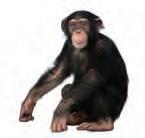
6 Look and trace letters. Write and draw. onkey

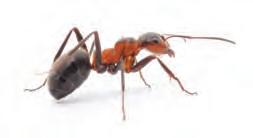
Objectives
• To identify initial sounds: /m/, /s/, /f/, /æ/
• To discriminate initial sounds
• To identify capital and lowercase letters: Mm, Ss, Ff, Aa
• To understand and follow simple commands
Vocabulary
moon, milk, monkey, sandwich, sun, seal, farmer, fish, fan, alligator, ant, sleep, march, fold, ask
Language
What is this?
What letter is this? It is the letter (m). What is this? A (sun). Is it a small m or a big M?
Materials
Class Audio CD; Happy Caterpillar puppet; Picture Cards or pictures of words that start with M, S, F, A; recycled paper or pieces of fabric
Place the Picture Cards that start with: /m/, /s/, /f/, and /æ/ on the board. Write the words above the corresponding picture on the board, omitting the first letter. Have Happy Caterpillar get children’s attention. Have him ask children about the missing sounds. Does monkey start with an s? Elicit children’s response: Yes, it does. / No, it doesn’t. Write m, s, f, and a. Have children help Happy Caterpillar classify the words under the letters. Repeat the procedure to review the remaining three sounds.
6 Look and trace letters. Write and draw Have children look at the pictures and say the words. What is this? Who is this? Have children say: It’s a (monkey). Then have Happy Caterpillar ask: What does monkey start with? Point at the letters on the board. Go over each of the words with children. Have children identify the big S in Sam’s name. Ask: What letter is this? Is it a small s or a big S?
Say the name Sam. Ask children what letter is missing. Have them trace the S and complete it with the letter a. Encourage children to use their finger in the air and trace letter a. Then have children draw a boy named Sam.
Ask children to keep their books open on their desk to Sam’s drawing. Ask them to walk around the classroom in small groups to look at the drawings. Elicit the importance of respecting others’ work. Encourage children to appreciate their classmates’ work. Talk about what they liked.
Have children sit in a circle and place recycled paper or pieces of fabric in the center so that children can fold them during the activity. Have children clap and say, one, two, three and you say: Turn around! Children mimic the action. Repeat with the rest the words sleep, march, fold, jump and dance.
Place pictures around the room of objects and animals that start with m, s, f, and a that children know. Ask children to form a circle. Have a child come to the center and have him or her say (help if necessary): I see a word that starts with a. The first child to say the correct word wins and goes to the center
Objectives
• To review numbers: 0–19
• To count to 19
• To count sets of ten
• To practice visual discrimination
• To practice fine motor skills
Vocabulary
look, stuffed animals, say, draw, trace, point, chant, roar, scratch, jump, clap, hop, blink, stomp
Language
This is a set of ten balls. How many balls do you see? Roar eleven times!
Materials
Class Audio CD, Happy Caterpillar puppet, stuffed animals, toys, varied objects
Animal Hunt!
Before class place 19 stuffed animals or any kind of object that could trigger the children’s curiosity around the classroom. Have children go around the classroom looking for the objects. Every time someone finds an object have him/ her keep it and sit down. When children find all of the 19 objects have them sit down. Once all the objects have been found, have the children who found them line up in front of the class. Have them raise what they found in the air one by one and have the rest of the class count out loud.
7 Count and say. Draw and trace. Have children look at the page and direct them to the balls at the top. Count the balls as a class. Ask: How many balls do you see? Ten. Then air draw the number 10 and have children imitate you. Next, point to the first picture of ten balls and say: This is a set of ten balls.
Help them count the balls as a class.
Next, have children trace the missing numbers. Continue the procedure for the rest of the numbers. Have children air draw them first.
Finally, have children point to and call out each number in unison.
A18 “Counting to 19 Chant”
Have children form lines of 19 (if there are children left over have them stand in their own line) and count off to 19. Then have them count while they chant. Tell children to jump or turn around when it’s their number to make it more fun.
Have children stand up. Call out actions (such as roar, scratch, jump, clap, hop, blink, and stomp) and a number of times to repeat each action: Roar eleven times! Have children carry out the action for the specified number of times.
Count and say. Draw and trace.

8 Trace letters. Cut out and paste.Trace and read.

Reading and Writing Readiness
• To identify and trace uppercase and lowercase letters: Ff, Ss, Mm, Aa
• To trace the word: a
• To read phrases using words and rebuses
• To learn the value: We respect others
• To understand and follow simple commands
Vocabulary fish, sandwich, monkey, ant, sun, moon, flower, snake, trace, cut out, paste, read, respect
Language
What letter is this? It is the letter (M). What is this? A (sun).
Materials
Class Audio CD, Happy Caterpillar puppet, Cutouts, music CD, Alphabet Poster, Values Poster, paper, pencils, glue, scissors

Sounds Fun!
On the board, write Ff, Ss, Mm, and Aa. Review their sounds as a class. Then play music for children to dance to. After a few moments, have Happy Caterpillar tap a pencil on your desk to get children’s attention. Have him point to Mm on the board. Children stop dancing and make the /m/ sound as loudly as they can until Happy Caterpillar taps the desk again for children to continue dancing. Repeat the procedure to review the remaining three sounds.


DURING PAGE 8 Cutouts






page 6 page 10









A16



8 Trace letters. Cut out and paste. Trace and read.






Display page 8 and point to each letter. Have children say the sound for each. Have Happy Caterpillar air draw each letter in turn. Ask: What letter is this? It is the letter (M). Have children mimic him. Then invite children to trace the letters. Next, guide children to the Cutouts. Have children say each word represented. Have them look back at the letters and match each Cutout to the corresponding letters. Finally, children stick the Cutouts in place.




Value: We respect others Display the Values Poster and ask children what they see. Elicit that the boy is opening the door for the girl. Say: The boy is showing respect. Next, role-play the scene on the Poster by having Happy Caterpillar open the classroom door for you to go through. Say: Thank you, Happy Caterpillar! Then invite pairs of children to repeat the procedure.

Distribute paper and pencils. Invite children to draw a picture of someone they respect: their mom, dad, sister, brother, etc. Then ask: What do we do to show respect? Elicit ideas such as open the door, let others speak, and so on. Finally, play the audio. Have children join in singing.
Direct children to the section at the bottom of the page and have them read the word a. Have them say the word while Happy Caterpillar air draws it. Invite children to mimic him. Next, have children trace the first a and focus on the rebus beside it. Ask: What is this? A sun. Repeat the procedure for the remaining rebuses.
Display the Alphabet Poster and invite four children to come to the front and find the letters Ff, Ss, Mm, and Aa respectively and make the sound of each letter. Have the class mimic them. Invite four more children to come up to find the corresponding picture on the Poster for each letter. As each picture is identified, have the class call out the name of the item.

See Workbook page 6.
Alphabet Song
Sing the song and have children join in when they can. Repeat the song several times.
A, B, C, D, E, F, G, H, I, J, K, L, M, N, O, P, Q, R, S, T, U, and V, W, X, Y, and Z. Now I know my ABCs. Come along and sing with me.


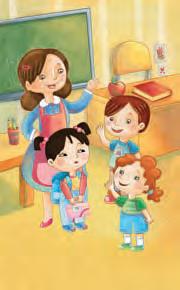


1. Teacher: This is our new friend, Tomoko.
2. Tomoko: Who is he?
Carol: He is the gym teacher.
3. Tomoko: What does he do?
Carol: He teaches us games.
4. Carol: He’s dancing!
Tomoko: We’re dancing, too.


Encourage children to take their books home to share with their families. Since this book covers several topics, including new classmates, school, and gym class, there are many things to talk about. The children in the story dance with hoops. Children may enjoy dancing with hoops at home, too.



Tell children that role-playing the story is something they can do as part of the end-of-the-year Show Time! Remind children that they are learning English for speaking in class and at home, but also for their Show Time celebration. It is important for them to have a context for their learning that they can understand.
Objectives
• To assemble a Little Book
• To listen to and read a story
• To role-play a story
• To review school workers
• To understand and follow simple commands
Vocabulary
gym teacher, hoops, friend, games, page, number, title, teach, dance, guess
Language
Who is (he)? (He) is the (gym teacher). What does he do? He teaches us games. He’s dancing. We’re dancing, too.
Materials
Class Audio CD, Happy Caterpillar puppet, Unit 1 Picture Cards, DVD or ActiveTeach, paper, crayons
Sing the Target Song
A8
Before singing the Target Song “People at School,” hold up each Picture Card in turn. Have Happy Caterpillar say each word and have children repeat after him. Then play the audio and have children join in when they can. Hold up the corresponding Picture Card each time a school worker is mentioned.
1. Have children turn to page 9. Show them how to tear out the page from the book and fold it in half to make a Little Book.
2. Preview the story with the class. Show children each page and ask: What do you see? Have children name people, colors, shapes, and other things. Praise all efforts.
3. Review the conventions of the Little Books with students: the title is on the front page; the page numbers help you find your place; the pictures help tell the story; and the drawings of the characters next to the lines tell you which characters are speaking.
4. Play the audio while you show children the pages. Don’t point or gesture—just let children listen and look at the pages.
5. Play the audio again. This time, point to the drawings next to the lines that show who is speaking. Point to the pictures to help clarify meaning.
6. Check comprehension. Point to different things in the story and ask: Who is he? Who is she? What does she do? Provide help with answers when needed.

Role-play
Role-play with the puppet to reinforce story comprehension. Use the gym teacher Picture Card as a prop to act out the story. Try to imitate the voices of the characters on the audio. Invite four children to the front and assign a character to each one. Have children mime the actions while you say the lines. Repeat with other children. Next, you may invite advanced children to role-play the story and say the lines. Praise all children for their efforts.
Have children take the story home to share with their families. Children can look at the pictures to remember the story and role-play with their families.

Play the DVD
As a final reward, show children the animated version of the story on the Big Fun DVD or in the ActiveTeach.

See Workbook page 7.
Guess the School Worker
Hand out paper and crayons. Go around the class, show a Picture Card of a school worker, and whisper the name to each child. Invite each to make a drawing of that person at school. When finished, invite a child to the front and have him/her show his/ her picture to the rest of the class. Invite him/ her to ask the rest of the class: Who is (he)? Encourage the rest of the class to guess which person it is: (He) is the (art teacher)! Once the person has been guessed, invite another child to the front and continue the procedure.
Objectives
• To review numbers: 0–19
• To count to 19
• To count sets of ten
• To practice visual discrimination
• To review days of the week
• To understand and follow simple commands
Vocabulary number, listen, say, count, stick, trace, roar, scratch, jump, clap, hop, blink, stomp, days of the week
Language
This is a set of ten markers. How many markers do you see?
Materials
Class Audio CD, Happy Caterpillar puppet, yarn, Stickers, a large calendar with the days of the week
Numbers 0 to 19
Section off a large portion of the classroom with yarn. Point to the space and ask: How many children are there? Say Zero and invite children to repeat after you. Then invite a child to the front, tap him/her lightly on the shoulder, and say: One! Have the rest of the class repeat after you. Have him/her enter into the sectioned off part of the classroom. Then invite another child to the front and elicit Two from the class. Continue the procedure until Nineteen. Each time, count from One and have the class join in.
Have Happy Caterpillar say Zero and have children repeat. Air draw a 0 and have children mimic you. Repeat the procedure for numbers 1 to 19. Play the audio and draw each number in the air in turn. Play it again and invite children to mimic your actions and join in when they can.


A19
9 Listen and say. Count, stick, and trace.
Play the audio. Have Happy Caterpillar say the numbers and invite children to repeat after him.
ten eleven twelve thirteen fourteen fifteen sixteen seventeen eighteen nineteen
Have children look at the page and direct them to the colored markers at the top. Count the markers as a class Ask: How many markers do you see? Ten. Then air draw the number 10 and have children mimic you. Next, point to the first picture of ten markers and say: This is a set of ten markers. Point the empty space for eleven and elicit how many are needed. Direct children to the Stickers and have them locate the one that illustrates the correct number. Help them count the markers as a class before having children stick the Stickers in place. Next, have children trace the number. Continue the procedure for the rest of the numbers. Finally, have children point to and call out each number in unison.
Sing “How Many Days?”
A4
Display a large calendar and have children look at it. Point to each day of the week, have Happy Caterpillar say the day, and have children repeat after him. Then play the audio and have children join in when they can. Have the puppet point to each day as it is mentioned.

See Workbook page 8.
Actions Dance
Have children stand up. Call out actions, such as roar, scratch, jump, clap, hop, blink, and stomp, and a number of times to repeat each action: (Roar fifteen times!) Have children carry out the action for the specified number of times.

Listen and say. Count, stick, and trace.



10 Look closely. Cut out and paste the cutouts in order.




Objectives
• To appreciate nature
• To observe details


for Unit 1









• To observe how bees work together to make a honeycomb
• To review school workers

DURING PAGE 12
page 6 page 10








10 Look closely. Cut out and paste the cutouts in order.
Drawing Honeycombs!


• To understand and follow simple commands
Vocabulary
bee, honeycomb, honey, look, cut out, paste, work, build, make
Language

This is a honeycomb. Bees work together to make a honeycomb. They build honeycombs to store honey. Do you like honey? Yes, I do./No, I don’t.
Materials
Class Audio CD, a jar of honey, Cutouts, Unit 1 Picture Cards, paper, crayons, sheets of colored paper, scissors, glue
Sing the “Amazing Nature” Song
A20
Have children stand and form a circle. Play the audio and use mime when appropriate. Have children mimic you. Then play the audio again and invite children to join in when they can.
Who Makes Honey?
Show children a jar of honey. Say Mmm and rub your tummy. Invite children to mimic you. Elicit what is in the jar or tell children that it is honey. Then ask: Who makes honey? Make a buzzing sound and pretend to fly around the room. Elicit: Bees. Tell children that they are going to learn about honey and bees today.



Display page 12. Point to the honeycomb and say: This is a honeycomb. Have children repeat honeycomb after you. Say: Bees work together to make a honeycomb. They build honeycombs to store honey. Then show a jar of honey. Say: This is honey. Ask children: Do you like honey? Next, direct children to the Cutouts for page 12. Encourage children to cut them out and to put some glue on the back of each picture. Then ask children to paste the Cutouts in the shaded areas in the corresponding order: The bee lands on a flower to pick up nectar. Bees work together to make honeycombs. People take the honey out of the honeycombs and store it in jars to eat.
A8 Sing the Target Song
Play Audio A8 and invite children to join in singing when they can. Show the corresponding Picture Card each time a school person is mentioned. Then invite volunteers who are ready to sing with the audio to perform the song. Invite each child to sing the names of the school workers as you hold up the appropriate Picture Cards. At the end, applaud all children.
Tell children that a honeycomb is a special shape made of six sides. Draw a hexagon on the board and say: This is a honeycomb. Count the sides of the shape as a class. Then hand out paper and invite children to draw a honeycomb, using your model on the board to help them. When finished, have children hold up their drawings for the rest of the class to see.

See Workbook page 9.
Busy Bees
Assign half of the class to be “bees” and the other to be “flowers.” Hand out a sheet of colored paper to each flower and have them stand around the classroom. Invite each bee to buzz around the classroom and tap each flower to start the process of making honey. Once all bees have visited each flower, have them congregate at the front of the class and mime making a honeycomb and honey. When finished, have children switch roles.
Objectives
• To do an art and science project
• To follow directions
• To use fine motor skills
• To review days of the week
Vocabulary
bee, honeycomb, days of the week, nose, tail, body, black, fold, tape, paint, stick, bend, cut, make, work, see
Language
Who makes honey? Bees. Do bees work together or alone? Fold and tape.
Paint the bee yellow and wait. Paint the bee’s nose and tail black. Make stripes. Bend and tape. Cut and tape. How many bees do you see? Two.
Materials
Class Audio CD, Happy Caterpillar puppet, a jar of honey, egg cartons, black and blue pipe cleaners, black and yellow tempera paint, scissors, tape, crayons, paintbrushes, a large calendar with the days of the week, music CD
Honey and Bees Review Display a jar of honey and have Happy Caterpillar ask children: Who makes honey? Elicit Bees and draw a hexagon on the board. Point to it and ask children what bees make to store honey in: A honeycomb. Finally, ask children: Do bees work together or alone? Elicit that they work together.
Before class, assemble the art supplies needed for the project. You will need egg cartons, black and yellow tempera paint, paintbrushes, scissors, tape, and black and blue pipe cleaners. Cut the tops off of the egg cartons and discard them. Cut the bottoms into parts, two egg sections in each part, and give one to each child. Show children page 13 and read the title of the project aloud: Make Bees. Then show children how to follow these steps:
1. Fold the piece of egg carton so that the egg sections form a rounded shape. Tape it closed. Say: Fold and tape.
2. Paint the bee yellow and wait for the paint to dry. Say: Paint the bee yellow and wait.
3. Paint the nose and tail black. Say: Paint the bee’s nose and tail black.
4. Take two strips of masking tape and paint them black. Wait for them to dry and have children tape them to make the bee’s stripes. Say: Make stripes.
5. Bend blue pipe cleaners to make wings. Tape them on. Say: Bend and tape.
6. Cut black pipe cleaners for antennae. Tape them on. Say: Cut and tape.
Point to Happy Caterpillar and read his speech bubble aloud: How many bees do you see? Have children count the bees on the page and say the answer aloud: Two.
Sing the “How Many Days?” Song Display the calendar and have Happy Caterpillar ask children: What day is it today? Invite a child to the front and have him/her point to and say the corresponding day. Have the rest of the class repeat the day after him/her. Then play the audio and invite children to join in when they can. Have Happy Caterpillar point to each day as it is mentioned.
Have children hold their bees. Play some music and encourage them to fly around the room and buzz like bees.






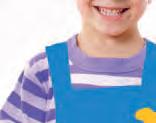















How many bees do you see?







11 Ask, answer, and check.




janitor gym teacher music teacher gatekeeper bus driver secretary principal English teacher

Who is he?


He is the janitor. He cleans our school.













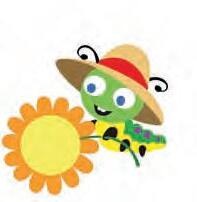
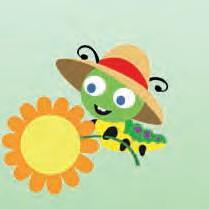



Objectives
• To assess vocabulary and language learned in the unit
• To prepare for Unit 9 Show Time
• To use Assessment for Learning to reflect on their own learning
• To understand and follow simple commands Vocabulary
janitor, gym teacher, music teacher, gatekeeper, bus driver, secretary, principal, English teacher, ask, answer, check
Language
Who is (he)? (He) is the (janitor). What does the (janitor) do? He (cleans our school). Where is the (secreatary)? (She) is (in the office).
Materials
Class Audio CD, Happy Caterpillar puppet, Portfolio Envelopes, paper, crayons

Stop and Sing
Revisit the songs and chants from Unit 1 (Audios A3, A4, A5, A6, A7, A8, A16, A18, and A20). Then invite a volunteer to the front. Have him/her say Stop! when he/she hears a song that he/she likes. Play the audio and encourage the whole class to sing along. You may repeat the procedure with other children and songs.

Think about Learning
Review Unit 1 page by page. Have children look at each page attentively and remind them what they learned on each, for example: What is this? What do you see? Who is (he)? What does (he) do? Where is the (secretary)? What letter is this? How many markers do you see? Do bees work together? Encourage children to clap if they liked the page or to make a sad face if they didn’t.
11 Ask, answer, and check.
Have children look at the first picture on the banner. Ask: Who is he? Elicit: He is the janitor Then ask: What does he do? Direct children to the picture below to help them answer. Lead them into saying: He cleans our school. Invite children to flip back to the Vocabulary pages to find a picture of the janitor and check their answer. Next, have children check the box beside the janitor. Continue the procedure for the rest of the school workers. Clap for a job well done!
Point out the mascot with the flower at the bottom of the page. Direct children to page 116. Help children decide what they liked most from Unit 1. Say: What I liked most from Unit 1 was learning about bees! Use an excited voice as you point to the bees on the Amazing page (12). Encourage children to draw what they liked most from Unit 1: a song or chant, the Little Book story, the Amazing project, or just a word. Reassure them that any personal response is fine! Revisit their ideas from Think about Learning.


After children complete their drawings, invite them to display them. Hold up a drawing and say: (Andrea) liked learning (school workers). (Daniel), did you also like that? What did you like, then? Provide English language support when needed. Repeat the procedure with the remaining drawings. Take notes on children’s preferences so you can determine what to include in the end-ofthe-year show.
Have children take home their drawings to show family members. Help children practice talking about their work so they can use English when they show it to their families.
Sing
A8
To consolidate what children have learned in the unit, play the Target Song “People at School.” First, practice the conversation with Happy Caterpillar. Then encourage children to join in and sing their part.
Have children review the things in their Portfolio Envelope to date. Walk to each child’s place and have him/her show you his or her favorite work. Make sure children put all pages back inside their Portfolio.

See Workbook page 10.